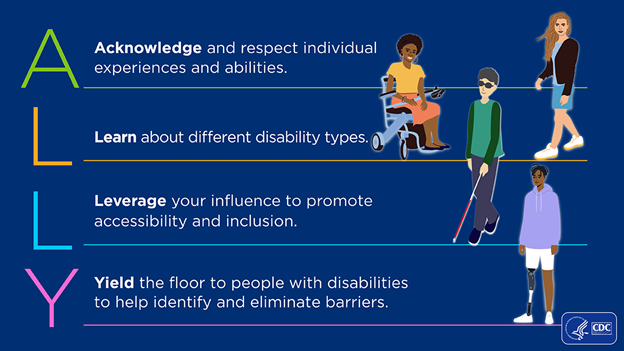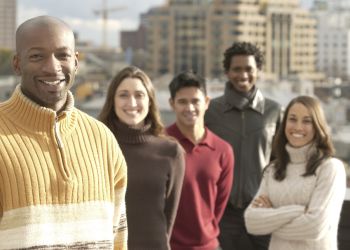This blog post was written by Nic Wyatt, Health & Disability Fellow at NACCHO.
“To put it bluntly, I, we, need to imagine crip futures because disabled people are continually being written out of the future, rendered as the sign of the future no one wants… It is my loss, our loss, not to take care of, embrace, and desire all of us. We must begin to anticipate presents and to imagine futures that include all of us.”
– Alison Kafer, Feminist, Queer, Crip
According to the World Health Organization’s World Report on Disability, over a billion people live with some form of disability worldwide, while in the United States, 1 in 4 (26%) adults live with a disability. As the aging population grows and long-COVID is acknowledged as a disabling condition within the Americans with Disabilities Act, projected estimates of people with disabilities are anticipated to increase. This growing population should be met with empathy and a desire to dismantle systems and structures functioning as barriers to full participation within their communities. Self-advocates from the disability community have been tireless catalysts for change, but change is spurred by organization and collaboration.
Local health departments (LHDs) and community-based organizations occupy unique positions within their communities. Such organizations may facilitate community growth and empowerment by encouraging and welcoming input from people with disabilities. LHDs can model true allyship by using their platforms to raise awareness, combat misconceptions, and elicit more support for concerns that people with disabilities have shared within their communities. These actions are inherently anti-ableist and may help decrease feelings of hopelessness people with disabilities experience without organizational support. The following recommendations are offered as a basis for organizations hoping to facilitate greater engagement and inclusion within their communities.
Prioritize inclusion for everyone
In the same way Universal Design acts in the best interest of all community members, developing inclusive programs and services yield benefits for everyone. As advocates Guy Caruso, Kathy Miller, and Jaclyn Nagle say, “People with disabilities have unique talents to offer to communities,” and LHDs can affirm the significance of their lived experiences by ensuring equitable access to programs and services. Disability is a natural part of the human condition. The exclusion of people with disabilities from community engagement only succeeds in reinforcing stigma and increasing experiences of social isolation in this population.
Inclusion must be intersectional
“Our culture, race, age, religion, gender, sexual orientation – as well as type of disability – all make a difference. They play a role in what happens in our lives and in the way people treat us,” – Uly Ramos
Intersectionality, or specifically, an intersectional view of disability, recognizes that disability status is not the only factor defining an individual’s experience of disability. Two individuals with the same disability may experience discrimination in different ways as a product of how facets of their identity intersect.
LHDs can better serve their communities when they are able to recognize what marginalized groups, like people with disabilities, communities of color, members of the LGBTQ+ community, could lend to society if their barriers are mitigated.

Text version of the image
ALLY:
- A – Acknowledge and respect individual experiences and abilities.
- L – Learn about different disability types.
- L – Leverage your influence to promote accessibility and inclusion.
- Y – Yield the floor to people with disabilities to help identify and eliminate barriers.
Advocate when no one’s looking
Supporting people with disabilities could also mean advocating for inclusion while partnering with other local organizations with or without individuals with disabilities present. The burden of education and advocacy on people with disabilities may result in feelings of burnout or withdrawal from community engagement. The ability to recognize and understand these feelings enable community-based organizations to shoulder some of that weight. While organizations could provide educational resources for community members to learn more about people with disabilities, it is important that they avoid assuming responsibility or authority over the disability experience. They should not presume to know what’s best for their community members with disabilities.
Amplifying the voices of people with disabilities means, first and foremost, to listen. Collaboration between LHDs and self-advocates can grant autonomy to a group that is often silenced. Coordination that addresses concerns of both parties, lack of access to community programming and low attendance for people with disabilities, for example, may ultimately strengthen relationships between all parties.
Ultimately, “Nothing About Us Without Us,” still holds true. People with disabilities must be allowed to make their own choices about their care and needs. A fruitful relationship between people with disabilities and LHDs should leave everyone feeling heard. Beginning from a place of understanding and with the best of intentions is a good place to start.

